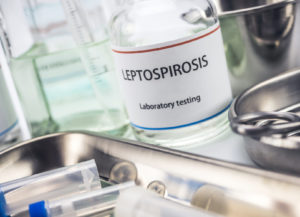
Spring rains bring flowers, but pet peril can lurk in standing water, mud puddles, and even swollen rivers and ponds. Invisible bacteria, 250 strains strong, lurk in warm, wet, stagnant areas. Leptospira can fight for survival for months in these areas after being shed by wildlife and rodents when they urinate.
Leptospirosis is a zoonotic disease, meaning it can affect both dogs and humans, and be transmitted from dogs to humans. It can cause severe kidney or liver failure, meningitis, difficulty breathing, and in some cases, lead to death. In some dogs, for reasons unknown, it can also be asymptomatic.
In recent years, pet health officials have watched the incidence rate increase across North America, so much so that the AKC Canine Health Foundation has funded two studies this year to explore the prevalence of “Lepto” and the immune response in dogs exposed to the bacteria.
While flood-prone areas and hurricane sites are at particular risk, Michigan is not immune to Lepto outbreaks. Statewide, incidents have been on the rise since 2015, according to the Michigan Veterinary Medical Association.
“Anywhere you have wildlife, leptospirosis can be spread into the environment through their urine,” said Dr. Laurie Brush, founder of Heaven at Home Pet Hospice.
“Prevention, and early detection, are paramount for your pet’s health,” she said. Ten to 15% of dogs diagnosed and treated will still succumb to the disease.
In order for a dog to get leptospirosis, they must have contact with an infected animal’s urine, which enters the body through wounds or mucous membranes (eyes, open mouth). Dogs most often get Lepto by drinking out of stagnant water sources, such as puddles.
Early signs of Lepto include:
 Loss of appetite
Loss of appetite- Increase or decrease in urine production
- Uncharacteristic inactivity
- Vomiting
- Diarrhea
- Abdominal pain
- Severe weakness and depression
- Stiffness
- Fever
The Veterinary community suspects that the cause of the rise in cases is two-fold. The CDC is investigating the appearance of new serovars, or strains of the bacteria. The vaccine does not protect against all strains. In addition, since the vaccine only lasts for a year, it is now typically delivered separately from core three-year vaccines, which gives pet parents the opportunity to skip the vaccination.
“While the vaccine is imperfect, it is the best prevention available against this disease. With such serious consequences, it’s worth discussion with your routine care veterinarian,” Dr. Brush said.
Even if your pet is vaccinated, avoid allowing them to drink standing water or eat animal carcasses since the vaccine does not inoculate against all strains of Leptospira.
Remember that early diagnosis is critical for an improved outlook, so if your pet shows early signs and is deteriorating quickly, treat it as an emergency. And since Leptospirosis can be transmitted to humans, practice good hygiene.
CDC Guidelines for Handling Pets with Leptospirosis:
- Do not handle or come in contact with urine, blood, or tissues from your infected pet before it has received proper treatment.
- If you need to have contact with animal tissues or urine, wear protective clothing, such as gloves and boots, especially if you are occupationally at risk (veterinarians, farm workers, and sewer workers).
- As a general rule, always wash your hands after handling your pet or anything that might have your pet’s excrement on it.
- If you are cleaning surfaces that may be contaminated or have urine from an infected pet on them, use an antibacterial cleaning solution or a solution of 1 part household bleach in 10 parts water.
- Make sure that your infected pet takes all of its medicine and follow up with your veterinarian.
